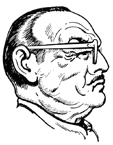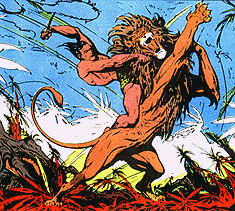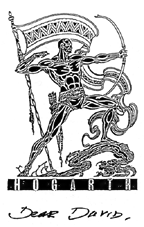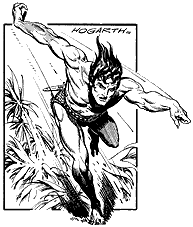| |
 SAVOY FIRST MET Burne Hogarth at the Hotel George, Earl's Court, in London on July 10th 1978. He was there to give a lecture
to a group of aficionados about the story dynamics and symbolism
placement in his recently published masterworks Tarzan Of The Apes and Jungle Tales Of Tarzan. We struck up a sporadic correspondence which lasted until his
death in 1996. The letters discussed the idea of a book, which
we suggested should be modelled on the volumes produced by American
imprint RE/Search and take the form an overview of his life and work. Although
we bought several short pieces off Burne, including his essay
Tarzan: A Myth Man in the Age of the Macromachine (for Savoy Dreams, 1984), and an introduction he wrote for James Cawthorn's The Crystal and the Amulet (1986), we never published the book. SAVOY FIRST MET Burne Hogarth at the Hotel George, Earl's Court, in London on July 10th 1978. He was there to give a lecture
to a group of aficionados about the story dynamics and symbolism
placement in his recently published masterworks Tarzan Of The Apes and Jungle Tales Of Tarzan. We struck up a sporadic correspondence which lasted until his
death in 1996. The letters discussed the idea of a book, which
we suggested should be modelled on the volumes produced by American
imprint RE/Search and take the form an overview of his life and work. Although
we bought several short pieces off Burne, including his essay
Tarzan: A Myth Man in the Age of the Macromachine (for Savoy Dreams, 1984), and an introduction he wrote for James Cawthorn's The Crystal and the Amulet (1986), we never published the book.
We agreed with Hogarth's own estimation of his work. He was a
giant in a world of pygmies, particularly in the field of comic
artists.
He was a dapper man, frequently dressed in smart sports jackets
that would not have been out of place at Lords or a gentleman's club such as The Garrick. Over the years, we have met many charismatically creative people
but nobody eclipsed Hogarth for his dynamism or for a wide and
eclectic knowledge of all the arts. He possessed a singular artistic
vision and intellectual rigour that was often at odds with his
contemporaries (most comic artists and writers being proudly anti-intellectual,
like their readers). The urgent expounding of his artistic vision
was off-putting to people weaned on the soundbites of modern journalism
and chat show blip-speak.
 A severe man, who championed the brave and original, he would
not suffer or reinforce the plaudits often given to the second-rate;
he knew the difference between Gerald Scarfe and Ralph Steadman, and why Scarfe was the greater artist. He always acknowledged
the debt he owed to Harold Foster, the founding father of the adventure strip, being well aware
of how his expansive evolution of the Foster style had paved the
way for the contemporary American comic book. As Gary Groth, editor of the Comics Journal, has said: A severe man, who championed the brave and original, he would
not suffer or reinforce the plaudits often given to the second-rate;
he knew the difference between Gerald Scarfe and Ralph Steadman, and why Scarfe was the greater artist. He always acknowledged
the debt he owed to Harold Foster, the founding father of the adventure strip, being well aware
of how his expansive evolution of the Foster style had paved the
way for the contemporary American comic book. As Gary Groth, editor of the Comics Journal, has said:
"Ironically, most of today's superheroes are fourth- or fifth-generation
bastardisations of Hogarth's original, pioneering efforts. No
artist working on adventure or superhero strips today has not
felt the influence of Hogarth's page design or anatomical stylisation."
 That supremely talented people like Foster and Hogarth, both the equal of any artist from the classic era of book illustration, are consistently ignored or passed over in the comments of contemporary comic artists in favour of hacks like Steve Ditko and Jack Kirby, speaks volumes about the ignorance of today's artists and goes
a long way in explaining the abysmal state of British and American
comics. In a medium which gives so much financial reward to superhero
garbage, this is probably to be expected. More surprising is the
way in which a man of Hogarth's intelligence was ignored by those
who could have presented him as an expert in every field of visual
art. David Sylvester's interviews with Francis Bacon for the BBC's Arena could have been one model; a Hogarth history of drawing, another.
All we get in their place are the inane ramblings of a gallery-bothering
nun and the perennial drivel of the Turner Prize. That supremely talented people like Foster and Hogarth, both the equal of any artist from the classic era of book illustration, are consistently ignored or passed over in the comments of contemporary comic artists in favour of hacks like Steve Ditko and Jack Kirby, speaks volumes about the ignorance of today's artists and goes
a long way in explaining the abysmal state of British and American
comics. In a medium which gives so much financial reward to superhero
garbage, this is probably to be expected. More surprising is the
way in which a man of Hogarth's intelligence was ignored by those
who could have presented him as an expert in every field of visual
art. David Sylvester's interviews with Francis Bacon for the BBC's Arena could have been one model; a Hogarth history of drawing, another.
All we get in their place are the inane ramblings of a gallery-bothering
nun and the perennial drivel of the Turner Prize.
The following letters from Hogarth give some idea of the form
Savoy's book might have taken.
 May 5th 1986 May 5th 1986
Dear David and Michael,
If these proof pages of Crystal and the Amulet are given in the size you attempt to publish, this will be an extraordinary publishing effort! Cawthorn is very fortunate to have your confidence and appreciation of his work to present such an augmented volume. It will be truly grandiose—and I cannot praise you enough for having the vision to give an artist in this idiom the chance to be exhibited and promoted in this fashion. More power and success to both of you. This is the way good works ought to be fashioned. I will look for excellent
results.
As to my lateness, I think I mentioned the one man show I have of my work in Marseilles, France. It was truly a major event there: two months (Oct, Nov and Dec) showing in the Bibliotheque Municipale; then extended for two more months—part of which was divided between the Hall of Arts and Sciences at Palais Langchamps, and at the Medlam Bibliotheque; the shows finally closed at the end of February. It made news all through France. It sent ripples across to Africa and to Tahiti (a newspaper there ran a full front page in their magazine section).
About the Bio-Book: I've been thinking about it, yes. In a way,
I've thought I might expand into some ideas I've had over time
in the past: one such, is a paper I wrote on the rise of the concept
of the human figure in the Greek world, called THE PLASTIC PRINCIPLE OF ART. It shows the relationship of the pose of human natural form concurrent with the rise of the Greek democracy—an original concept. Then, I have a theory of the nature of humour—an analytical approach dealing with an original concept which I call 'The Collapse of Tension Theory'—documented with detailed examples. This is developed in a discussion of the various categories of humour.
Another idea I have is to write about a new series of lectures I've been giving at Art Centre in Pasadena on Symbols and Iconography—five categories of symbols and the relevant descriptions of these in art works from early Tuscan art to the present day—documented and illustrated with historical examples.
Cordially,
Burne Hogarth
November 1987
Dear David and Michael,
Let me thank you for your fulsome understanding and co-operation.
I shall from here on, no matter what transpires in my immediate
concerns, continuously and overidingly have this project on my
mind. Shortly, I shall start mapping out some of the materials
I shall like to see included, and I will be giving you some ideas
in specifics as to what these might be. I will need your suggestions,
too. This first stage will be tentative and exploratory. But it
will give me a base for later refinement and upgrading.
One thing I would like to feel uppermost in The Broad Scope of this book:
a. I have a fair(ly) large quantity of artwork of a number of idioms and expressions. I want the book to explore these, and I will make some very
specific comments on all of these. I am not one of those 'bozo's'
who is at a loss for words to speak clearly on my art and what
I mean by it.
b. I have a number of theoretical concepts I want to include—one, a theory of humour, which I believe is an original and unexplored approach;
another, a theoretical approach to symbols and Symbolism; a third, a problem relating to design and the cultural relativism
of space division and focus of design flow. There are others relating
to figural understanding, etc. But I won't bore you now with these.
c. I have some ancilliary interests in writing which I will air later and hope to include; essays, some poems,
perhaps.
d. The least of the material will be the biographical matter,
which I will sketch in and augment from time to time. This area
is not my greatest pursuit or achievement.
In the main, it should smack of art and art's concerns all through. Therefore, the first and immediate task for me now, is to go for a title that some positive content, and means something in the long run.
So, here are a few I've been toying with. I'll put them down here,
and let you test for reactions. I'm not committed to any one at
this time:
ELLIPTICAL EYE
THE ECLECTIC EYE
THE DYNAMIC EYE
THE QUESTING EYE
THE EYE AT LARGE
THE REFRACTIVE INSCAPE
INSCAPE AND MINDSCREEN
THE FORESHORTENED UNIVERSE
THE INTERIOR MIRROR
THE 'I' IN FOCUS
THE SPLIT-SECOND INSCAPE
These are a few of the suggestions. One or two may make a title
(pro-tem); what do you think?
I'm not thinking of the number of pages at this time. Only content; but you may have a more definite
conception of budget and I trust it isn't too fine-honed, just
yet.
Let me turn to the story of Kitzel/Pixyl. I know I pushed on too quickly with these names—a collapsed, warped space conflict. Let me explain. When I wrote the original name, Kitzel (translates 'Tickle' in German), I thought it had exactly what
I wanted, character, charm, child-orientation, toy-probablity,
etc. When my producer accepted it, a good friend here, Jack Cummings
(producer of Seven Brides, Kiss Me Kate, etc), said he thought the title had been used in the dim past as a character on Jack Benny Comedy Radio Show. This was still being syndicated. I was flabbergasted. My attorney, on question,
agreed: the doubt was enough to scotch the idea and move for alternate
name. When the flute idea brought in James Galway as possible
music player and voice narrator, I jumped to the notion of a 'Pixy'
voice to augment Galway's brogue. So came to the name 'Pixyl' as the alternative—and every one here seemed to go with it.
I'm glad to be fairly ahead with this project, and I do thank
you both for your continuing interest. Please let me know if any
of the proposed titles are close to the mark.
With all good wishes for an exciting time ahead.
Cordially,
Burne Hogarth
(SAVOY NOTE: Hogarth's last published book before his death was
a collection of sketches entitled The Arcane Eye Of Burne Hogarth, from Fantagraphics)
March 24th 1988
Dear David and Michael,
I am herewithin happy to send your signed copy between Savoy Books and me for the projected autobiography. I spend a good deal of time thinking about the contents and the form of this work, and soon I shall begin to talk into some tapes just to get the feel of some ideas that float around as possible material. Because this is 'serendipity' phase—mulling things over—-it is like lying in bed on an early Sunday in warm spring, with a full day ahead and lazing with one's feet and legs slowly moving, testing the sensuous feeling before getting up, unhurried, to do nothing but wander; and get back in bed to do nothing more than test the sheets on one's legs, just once again.
It's good to have this in the back of my mind—because now I can think I'll really have a place in here to argue out a THEORY OF HUMOUR, and analysis of Symbols and Symbolisms involving art forms and the like.
So many thanks for the opportunity to play on this level.
Cordially,
Burne Hogarth
November 18 1995
Dear David,
The long hiatus between receiving and answering your letter and
package of books of Reverbstorm by John Coulthart is due, not
to disinterest, but to a long passage of a deadline commitment
on doing a new graphic novel with a new hero for Dark Horse Inc.
I'll reveal more of this new theme some later time, but I wanted
to acknowledge your letter before any more time slips by.
Frankly, I was much puzzled by Coulthart's opus in the oversize pages of your publication. I have not seen in many a long series of months—or years—the kind of continued dedication to the punctilious and meticulous pen and ink work put on board by your artist. It's a striking example of the need to create and the desire to shock the sensibilities of an audience with a phantasmic subject linked to a febrile and phantasmagorical talent. I recognise, of course, certain derivative aspects in the creation of these pieces—some of my Ononoe material in some character delineations; some uses of Gustave Doré's work in atmospheric, dark, foreboding evocations (which includes Berni Krigstein's (sic) Frankensteinian necrophiliac severity); and we could include here echoes of the umbrageous, pitiless vehemence of Francisco Goya—in The Disasters and the witches' sabbath fulminations; and he could be linked
to the medieval world of Bosch, Grünewald and Breughel and the
Black Plague in the 'Memento Mori' inclusion.
Withal, it may be seen as influences in this work—there is a body of interest here that is distinctively and pointedly personally original—this is, Coulthart's incisive and unremitting malevolence. His work is a persistently orchestrated charnel-house of frightfulness, pitiless night-terror ruthlessness.
Well... It's a cleverly designed, executed, seductively presented,
venomously concocted pastiche of urbane, suave comic book art!
Quel masquerade! A hymn of hate in the guise of loving abomination,
affectionate affliction, and benevolent detestation.
My thanks to you on your good words to me!
In all good friendship and best wishes,
Hogarth.
(SAVOY NOTE: The new graphic novel referred to above was Morphos The Shapechanger, his final work, published by Dark Horse Comics in July 1996.)
John Coulthart comments: As one would expect of a person with
Burne Hogarth's intelligence and knowledge of art history, his
appraisal of my work in Reverbstorm #4 managed to zero-in precisely on specific, persistent influences of mine (especially Gustave Doré), even where those influences aren't so apparent. I feel fortunate to have received such honest and generous criticism for a work whose content ran counter to Hogarth's deeply felt artistic philosophy; we were also extremely fortunate to receive this communication three months before his death. The world is a smaller place without him. •
|

 SAVOY FIRST MET Burne Hogarth at the Hotel George, Earl's Court, in London on July 10th 1978. He was there to give a lecture
to a group of aficionados about the story dynamics and symbolism
placement in his recently published masterworks Tarzan Of The Apes and Jungle Tales Of Tarzan. We struck up a sporadic correspondence which lasted until his
death in 1996. The letters discussed the idea of a book, which
we suggested should be modelled on the volumes produced by American
imprint RE/Search and take the form an overview of his life and work. Although
we bought several short pieces off Burne, including his essay
Tarzan: A Myth Man in the Age of the Macromachine (for Savoy Dreams, 1984), and an introduction he wrote for James Cawthorn's The Crystal and the Amulet (1986), we never published the book.
SAVOY FIRST MET Burne Hogarth at the Hotel George, Earl's Court, in London on July 10th 1978. He was there to give a lecture
to a group of aficionados about the story dynamics and symbolism
placement in his recently published masterworks Tarzan Of The Apes and Jungle Tales Of Tarzan. We struck up a sporadic correspondence which lasted until his
death in 1996. The letters discussed the idea of a book, which
we suggested should be modelled on the volumes produced by American
imprint RE/Search and take the form an overview of his life and work. Although
we bought several short pieces off Burne, including his essay
Tarzan: A Myth Man in the Age of the Macromachine (for Savoy Dreams, 1984), and an introduction he wrote for James Cawthorn's The Crystal and the Amulet (1986), we never published the book.  A severe man, who championed the brave and original, he would
not suffer or reinforce the plaudits often given to the second-rate;
he knew the difference between Gerald Scarfe and Ralph Steadman, and why Scarfe was the greater artist. He always acknowledged
the debt he owed to Harold Foster, the founding father of the adventure strip, being well aware
of how his expansive evolution of the Foster style had paved the
way for the contemporary American comic book. As Gary Groth, editor of the Comics Journal, has said:
A severe man, who championed the brave and original, he would
not suffer or reinforce the plaudits often given to the second-rate;
he knew the difference between Gerald Scarfe and Ralph Steadman, and why Scarfe was the greater artist. He always acknowledged
the debt he owed to Harold Foster, the founding father of the adventure strip, being well aware
of how his expansive evolution of the Foster style had paved the
way for the contemporary American comic book. As Gary Groth, editor of the Comics Journal, has said:
 May 5th 1986
May 5th 1986